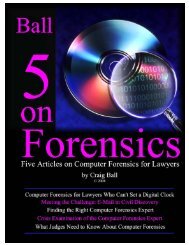Six Articles on Electronic - Craig Ball
Six Articles on Electronic - Craig Ball
Six Articles on Electronic - Craig Ball
You also want an ePaper? Increase the reach of your titles
YUMPU automatically turns print PDFs into web optimized ePapers that Google loves.
<strong>Craig</strong> <strong>Ball</strong> © 2007<br />
Another reas<strong>on</strong> back up tapes lie at the epicenter of e-discovery disputes is that many<br />
organizati<strong>on</strong>s elect to retain back up tapes for archival purposes (or in resp<strong>on</strong>se to litigati<strong>on</strong> hold<br />
instructi<strong>on</strong>s) l<strong>on</strong>g after they’ve lost their usefulness for disaster recovery. Here again, when<br />
data has been deleted from the active systems, the stale back up tapes are a means (joined by,<br />
inter alia, computer forensics and discovery from local hard drives) by which the missing pieces<br />
of the evidentiary puzzle can be restored.<br />
In organizati<strong>on</strong>s with many servers, back up systems are complex, hydra-headed colossi.<br />
There may be no simple <strong>on</strong>e-to-<strong>on</strong>e corresp<strong>on</strong>dence between a server and a particular user,<br />
and most tape back up systems structure stored data differently from active data <strong>on</strong> the server,<br />
complicating restorati<strong>on</strong> and explorati<strong>on</strong>. Volume, complexity and the greater time it takes to<br />
access tape compared to disk all c<strong>on</strong>tribute to the potentially high cost of targeting back up<br />
tapes in discovery. Compelling a large organizati<strong>on</strong> to interrupt its tape rotati<strong>on</strong>, set aside back<br />
up tapes and purchase a fresh set can carry a princely price tag, but if the tapes aren’t<br />
preserved, deleted data may be g<strong>on</strong>e forever. This is the Hobs<strong>on</strong>’s choice 5 of e-discovery.<br />
A preservati<strong>on</strong> letter should target just the backup tapes likely to c<strong>on</strong>tain deleted data relevant to<br />
the issues in the case—a feat easier said than d<strong>on</strong>e. Whether by Internet research, c<strong>on</strong>tact with<br />
former employees or c<strong>on</strong>sultati<strong>on</strong> with other lawyers who’ve plowed the same ground, seek to<br />
learn all you can about the architecture of the active and backup systems. The insight gleaned<br />
from such an effort may allow for a more narrowly tailored preservati<strong>on</strong> request or justify a much<br />
broader <strong>on</strong>e.<br />
The resp<strong>on</strong>ding party need not retain purely cumulative evidence, so <strong>on</strong>ce established that data<br />
has not been deleted and all relevant informati<strong>on</strong> still exists <strong>on</strong> the servers, the back up tapes<br />
should be released to the rotati<strong>on</strong>. Again, this is a goal more easily stated than achieved<br />
because it requires three elements too often absent from the adversarial process:<br />
communicati<strong>on</strong>, cooperati<strong>on</strong> and trust. Hopefully, the advent of compulsory meet-and-c<strong>on</strong>fer<br />
sessi<strong>on</strong>s will force litigants to focus <strong>on</strong> e-discovery issues sufficiently early to stem unnecessary<br />
costs by narrowing the breadth of preservati<strong>on</strong> efforts to just those acti<strong>on</strong>s or items most likely<br />
to yield discoverable data.<br />
Drive Cl<strong>on</strong>ing and Imaging<br />
Data deleted from a pers<strong>on</strong>al computer isn’t g<strong>on</strong>e. The operating system simply releases the<br />
space the data occupies for reuse and treats the space as available for reuse. Deleti<strong>on</strong> rarely<br />
erases data. In fact, there are three and <strong>on</strong>ly three ways that informati<strong>on</strong>’s destroyed <strong>on</strong><br />
pers<strong>on</strong>al computer:<br />
1. Completely overwriting the deleted data <strong>on</strong> magnetic<br />
media (e.g., floppy disks, tapes or hard drives) with new<br />
informati<strong>on</strong>;<br />
2. Str<strong>on</strong>gly encrypting the data and then “losing” the<br />
encrypti<strong>on</strong> key; or,<br />
3. Physically damaging the media to such an extent that it<br />
There are three and<br />
<strong>on</strong>ly three ways that<br />
informati<strong>on</strong>’s destroyed<br />
<strong>on</strong> a pers<strong>on</strong>al computer<br />
5 Thomas Hobs<strong>on</strong> was a British stable keeper in the mid-1600s whose policy was that you either took the horse<br />
nearest the stable door or he wouldn't rent you a horse. “Hobs<strong>on</strong>'s choice” has come to mean an illusory<br />
alternative. Back up tapes are problematic, but the unacceptable alternative is letting evidence disappear.<br />
55













